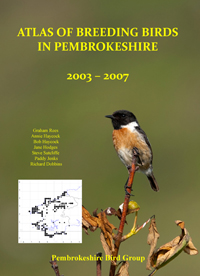Indigo Bunting - 1996 - first for Pembrokeshire
 Tuesday, December 24, 2013 at 10:48AM
Tuesday, December 24, 2013 at 10:48AM The phone went at first light. "Darren's found a bird, and it's definitely not a Rosefinch". It was Sue on Ramsey island, and her words were enough to have me reaching for my waterproofs, notebook and car keys. In the next few minutes I phoned local birders for a couple of companions, and Rod Hadfield and Byron Davies were already at the lifeboat station as I ran down the steps. While we butted across the Sound in the Ramsey boat "Shearwater", I had time to review Darren's roll of honour. Darren Woodhead first came to Ramsey as an art sutdent several years before. On the island in October 1993 to prepare some illustrations for our reception displays, he had identified a Pied Wheatear which landed on the farmhouse fence beside him. Staying with us in late October 1994 he stumbled across a Yellow-rumped Warbler in one of the east coast valleys, which eventually treated over 400 birds to spectacular views. Darren . . . October . . . . an unusual bird . . . the same heady combination.
While walking down to the farmhouse at 12:30 the day before, a small bird had landed on the stone wall ahead of him. At first glance it had seemed rather Rosefinch-like; and yet . . . . It flipped over into the rushes beyond the famhouse garden to find shelter from the horizontal rain, so Darren stalked it and waited. At last, up onto the wire fence; yes - dark eye in a plain face, no striking features, finch-like bill, but . . .only a single wing-bar, and dark legs? Something not right.
As the four of us surrounded the garden that next morning, we were all looking for the same details, but Darren had another name to tantalise us with, for after detailed field sketches and a frantic search through the field guides, he hadn't been able to shake another name from his head: Indigo Bunting.
A movement in the garden: up to a wire tree-guard, then up the valley into the rushes. A careful stalk past the gorse and we found it, perched in Juncus clumps, feeding on the seedheads like a Linnet. From a distance a two-tone impression like a Spotted Flycatcher, silvery grey below, browner above. But only the faintest streaking on a grey gorget, darker brown back with traces of grey streaks, a distinctly warmer tan head reminiscent of female Blackcap, dark eye in plain face, a finer, bunting-like bill, and yes: dark grey legs. Remiges and tail feathers appeard dark grey, black tertials with a striking white wedge in the innermost two. As the bird turned and fluffed, at last the key colours: a glint of smoky cerulean blue on the tail and the innermost median and lesser coverts. A last check on our notes a comparison of four different field guides, and a final nail-biting consensus: reach for that phone!
Onto Birdline by lunchtime, only 8 bumpstart birders made it across before dark on the Saturday. But at dawn on the Sunday, a Force 7 wind and lashing rain, over 300 sodden figures waiting patiently on the lifeboat steps staring longingly across Ramsey Sound. In horrendous conditions we got across all those who waited. By the week's end over 500 had made the pilgrimage, and the amazing little bird, now stoking up on crane flies and blackberries but still faithful to the same tiny valley, had stayed to delight everyone who came to see it. Af first winter bird, on a west coast island after gales in late Ocxober . . . we leave it to the experts to decide if it is genuine or not!
Ian Bullock, RSPB Warden, Pembrokeshire.
(The experts are the British Birds Rarities Committee, who will adjudicate the correctness of the identification and the British Ornithologists' Union Records Committee who will assess whether this bird was a genuine vagrant or an escape from captivity. The Indigo Buting is a common wild bird in the USA but is also kept as a cage-bird in Europe)
Pembrokeshire Bird Report 1996
 IDB,
IDB,  Ramsey,
Ramsey,  Rarity in
Rarity in  Indigo Bunting
Indigo Bunting 

